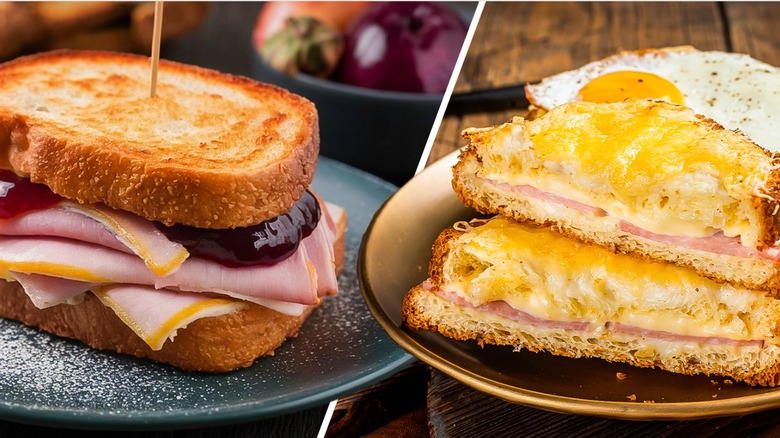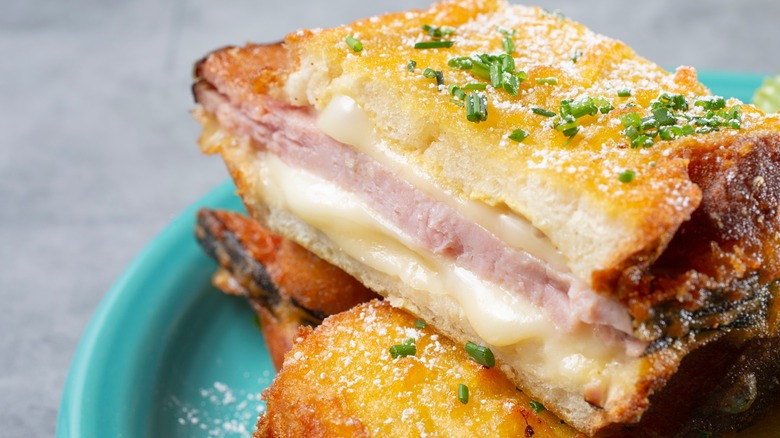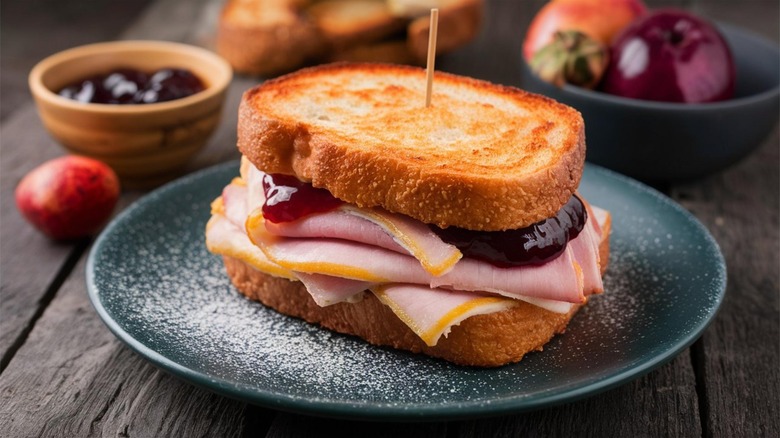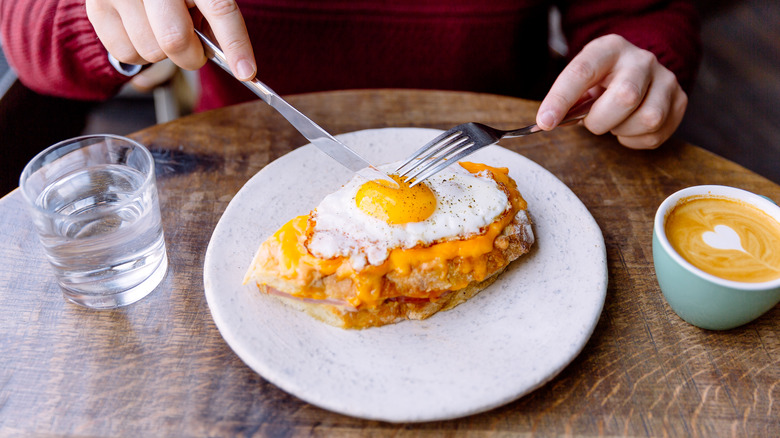Monte Cristo Vs Croque Madame: What's The Difference?
When the sweet siren of a warm, filling, buttery sammy comes calling, the Monte Cristo and the croque madame can both get the job done. Both sandwiches are upscale ham-and-cheeses thought to be descendants of the classic French croque monsieur. But, whether you're craving sweet-salty or straightforward savory will determine which sandwich might better soothe the savage beast.
Monte Cristo sandwiches are about as complex, flavor-wise, as it comes: battered, fried, powdered, sliced into triangles for an ooey-gooey cheesy dreamboat that takes a major design cue from French toast. Croque madames, by comparison, are still rich but more understated. However, foodies would be remiss to confuse "understated" with "boring." Our ultra-savory croque madame recipe inspired by the esteemed Jack's Wife Freda in NYC swaps the ham for duck bacon, and the traditional version is still fried and sauced. So, what's the diff between these crunchy beauties?
Both Monte Cristos and croque madames start with a base of ham and Gruyère cheese, but they diverge pretty majorly from there. Monte Cristos are battered, smeared with jam and mustard for a sweet-sharp taste, and dusted with powdered sugar, while croque madames are draped in moist, creamy béchamel for a savory, rich, moist profile that is in no way sweet.
What is a Monte Cristo?
The Monte Cristo is the legendary crossover between French toast and a ham and cheese sandwich. "Balanced hedonism" is the name of the game here — neither too sweet nor too salty. To make it, sliced ham and Gruyère cheese are sandwiched between a sweet-savory slather of both raspberry jam and Dijon mustard. Swiss cheese is also common instead of or in addition to Gruyère.
The shining star of the Monte Cristo is the bread (typically sturdy white Texas toast or brioche), which gets dipped in egg batter and pan-fried to a mouth-watering golden brown crustiness. In classic French toast style, the egg batter is spiced with cinnamon, nutmeg, and vanilla, which lend even more sweet depth to this warm, dimensional sammy. To finish, Monte Cristos are sprinkled with a dusting of powdered sugar and served with an extra dish of berry preserves on the side for dipping. If you like it tangier, you could dip the sandwich in extra Dijon instead.
To complete the meal, serve your Monte Cristo with classic potato chips or a fresh arugula salad dressed in an acidic vinaigrette to cut through the richness of the sandwich. It's eaten as commonly with a fork and knife as with hands; this is a formidable sammy.
What is a croque madame?
Croque madames are a classic French bistro sandwich loaded with ham and Gruyère cheese, draped in luxurious béchamel (a foundational French mother sauce), and topped with a fried egg. Soft, thick white bread like brioche or sourdough is topped with thinly sliced ham, grated Gruyère, and a little béchamel, then topped with another slice of buttered bread and pan-fried grilled-cheese-style, creating a layer of bubbly golden brown cheese that's toasted rather than gooey-melted. Some preparations also add grated cheese into the béchamel, making it a mornay sauce. Once toasted, the sandwiches are slathered in the remaining béchamel, topped with a fried egg, and sprinkled with a generous layer of salt and pepper to serve. We even like to make our croque madames on store-bought croissants for a buttery, flaky finish.
Like the Monte Cristo, croque madames are served hot and best enjoyed with a fork and knife. But, unlike Monte Cristos, in croque madames, using high-quality, thick-sliced, boiled or roasted ham over thinly sliced packaged deli ham will make a big difference in the flavor and texture of the overall sandwich. To complete the meal, pair your croque madame with a lemon-dressed arugula salad topped with thick-shaved Parmesan, and a bowl of crunchy, tangy cornichons on the side.
Monte Cristos are sweet-salty-tangy while croque madames are savory
In the Monte Cristo, the moisture element comes from mustard and raspberry jam, while in the croque madame, the moisture comes from the runny egg yolk and béchamel. As such, these different ingredients yield wildly different flavors, with the Monte Cristo being a sweet-salty, fried and battered fantasia, and the croque madame being a comparatively tamer savory sammy.
The mustard-jam Monte Cristo served on French toast is a flavor bomb that knows nothing of discretion (and therein lies its power and enduring popularity). By comparison, the boldest part of a croque madame is the interplay of the sharp Dijon mustard with the smoky ham and creamy mornay sauce. As it warms, the runny yolk of the fried egg combines with the sauce for a moist, rich bite and ultra-savory flavor. Croque madames are also commonly garnished with fresh chopped tarragon, chives, or thyme, which adds both a pop of color and a subtle herbaceousness.
Monte Cristos are typically served as a breakfast or brunch dish, but this American diner classic also makes a killer late-night bite with a cup of decaf coffee. (Pro tip: The Monte Cristo is also a legendary hangover brekky, for the record.) Croque madames make a knockout brunch, but in France today, the sandwich is most commonly served as a lunch or dinner dish.
Croque madames are French, and Monte Cristos are ... complicated
Monte Cristo sandwiches began popping up on cafe menus across California as early as the 1950s. Disneyland has been serving Monte Cristos at its Café Orleans since the 1960s, which could suggest a Louisiana origin for the sammy. Before that, Alexandre Dumas's French adventure novel "The Count of Monte Cristo" was published in 1844, and still further back, Montecristo has been a real place for centuries. It's a volcanic island off in the Tuscan archipelago. So, is it French, American, or Italian? The exact "when and where" of the Monte Cristo remains unclear, but either way, over time, the sandwich has assumed an identity attached to the American diner scene.
Croque madames have a less murky origin story, being served in French bistros for over 100 years. In fact, croque madame translates to "Mrs. Crunch," a playful name that references how the egg-topped toast resembles a traditional woman's hat. However, exactly when this now-classic sandwich evolved from the croque monsieur and broke onto the scene as its own variation is unknown. According to most sources, its origin is more or less yolked (pun intended) with the croque monsieur, which originated in a Paris cafe in 1910 and was mentioned by name in Marcel Proust's 1918 novel "In Search of Lost Time," suggesting that the sandwich (or at least its masculine predecessor) was already cemented as such a staple dish that French readers would be able to recognize it.




